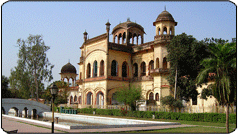Qaiserbagh and Pari Khana
With her distinctive charm, grace and sophistication, the courtesan is a. fascinating character often romantically linked with Awadh's culture, particularly that of Lucknow.
The State Folk Art Museum today is housed in a building that was in the times of Wajid Ali Shah [when he was the heir-apparent] famous as Pari Khana, or the abode of fairies. It had a large number of young, beautiful, talented females, usually drawn from the families of courtesans, dedicated to the promotion of music and dance. These often had the suffix of Pari attached to their names for roles in Rahasya (plays) organised for Wajid Ali Shah, hence the name Pari Khana.
The courtesan in Awadh, with her refined social etiquette and manners was a class unto herself. Many enjoyed the patronage of rulers and even the British Resident when they were called upon to perform mujra (dances) or sing ghazal in special functions and private gatherings.
The practice was banned during the reign of the fourth king, Amjad Ali Shah, who acting on the orders of Shia high priest, Sultan-ul-Ulema ordered professional singers, dancers and musicians to leave the city. But the order seems to have had no influence on his own son and heir apparent Prince Wajid Ali who continued to patronise them. Conversant with the art of playing the tabla and sitar, he composed musical compositions that were set to ragas.
The large central hall of the Pari Khana was decorated with numerous chandeliers while a marble-floored courtyard with porcelain flower pots outside set the stage for open air functions. It was connected with a bridge over a canal that formed part of Lanka in the Qaiser Bagh gardens. Life-sized marble statues and tall lamp posts lined along the canal provided a scenic backdrop for the performances of the courtesans. (All these were destroyed during the recapture of Lucknow by the British in March 1858, when the institution was closed down). A number of musicians and dance masters were attached to the Pari Khana to instruct the artists. The female members of the Pari Khana resided with eunuchs in attendance in the mahalsara of Qaiser Bagh that was heavily guarded by female sentries trained in martial arts, use of weapons and firearms.
In his book Banni, Wajid Ali Shah has listed 192 female artists under different categories, employed in the Pari Khana. If the King desired an intimate relationship with any of them, he solemnised a mutah (temporary marriage) which was later converted into a nikah if the lady conceived. Wajid AN Shah is said to have performed mutah with as many as 112 of these ladies of the Pari Khana.
The Canning College, later upgraded as the Lucknow University, was originally started here in 1878, according to Sheikh Tassaduq Hussain in Begumaat-e-Awadh. The Pari Khana revived its tradition of music and dance in the early 20th century when it started functioning as the Marris College of Music in an atmosphere entirely different from the Pari Khana. It is today renamed as the Bhatkhande College of Music, a deemed University.
Source:
Hindustan Times, City Scan, A Time in History
Wednesday 8.4.1998 — The abode of fairies

